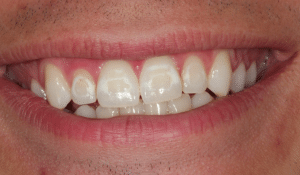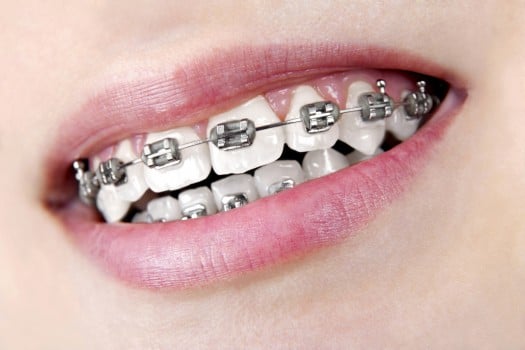White spots are a very real threat to brace wearers. It is estimated that between 10 and 20 percent of brace wearers will develop those unsightly white spots that become visible when the braces are taken off.
What are White Spots?
White spots are essentially the beginning of a cavity. There is a cocktail of bacteria that naturally occurs in your mouth. All they are looking for is a place to replicate. Dental plaque is a great place for them to do it. And with hard-to-clean spots and large surface area, braces are a great place for plaque to form. The main two culprits in plaque that cause white spots are streptococcus mutans and lactobacillus.
These bacteria use the sugars in food to reproduce. As they multiply, they form acids. This acid leaches the calcium out of your teeth in a process known as decalcification. Once the calcium is absent, the acids create thousands of microscopic holes in the enamel that give off the milky-white appearance that characterize white spots.
Prevention

Getting rid of the food (and the sugars that are in them) after you eat is a proactive way of stopping those harmful bacteria from reproducing. Some tips to help with cleaning:
- Rinse (after every meal)
- Floss (nightly)
- Brush
- Repeat
- Use prescription-strength fluoride toothpaste (like Colgate PreviDent 5000 plus)
- Use a Sonicare toothbrush (electric oscillations help to reduce plaque buildup)
- Try a Waterpik (to make cleaning quicker and easier) if you don’t have gum disease
- Use plaque-disclosing tablets once a week (to identify where the plaque is hiding)
White Spots and Your Diet
What you eat can impact the formation of white spots. Here are some helpful diet tips to reduce the likelihood of white spots with braces:
- Eat foods lower in sugar (to reduce the amount of fuel for acid-forming bacteria)
- Drink water instead of soda or fruit juice
- Eat full meals instead of snacks
Getting Rid of White Spots
Only about 10% of people with white spots will see them worsen and even fewer (6%) will need them restored. Prevention is always the best option for white spots. Although there are no fixes once they start, there are means of making them less unsightly.
Remineralization with Extra Fluoride
One way is to remineralize the tooth by applying higher-than-usual doses of fluoride to the area for short periods after your braces come off. Over exposing the white spot to heavy fluoridation can cause it to turn brown.
-
Paste
This can be applied to white spots that are forming while the braces are on. Its active ingredient—Amorphous Calcium Phosphate (ACP)—crystallizes to create apatite, which is the mineral content of teeth.
-
Gum
Believe it or not, chewing gums that are high in ACP, like Trident Xtra Care, are employed to remineralize your teeth at a slow rate.
Microabrasion
This technique utilizes an abrasive compound to remove the stained area, going slightly beneath the tooth’s surface until the stain is gone, leaving a smooth enamel finish.
Restoration
There are more active treatment plans that involve the introduction of tooth-colored resins or composites, and, in some instances, the application of porcelain veneers.
At Orthodontic Associates, we believe that following prevention protocols and keeping your appointments are the best way to keep plaque from building up and unsightly white spots from forming. We use state-of-the-art techniques and appliances to minimize the amount of time our patients spend in braces so that they can lessen the likelihood of white spot formation.
Contact our staff today to set up your initial consultation at any of our nine locations around Baltimore. We look forward to making you smile.



